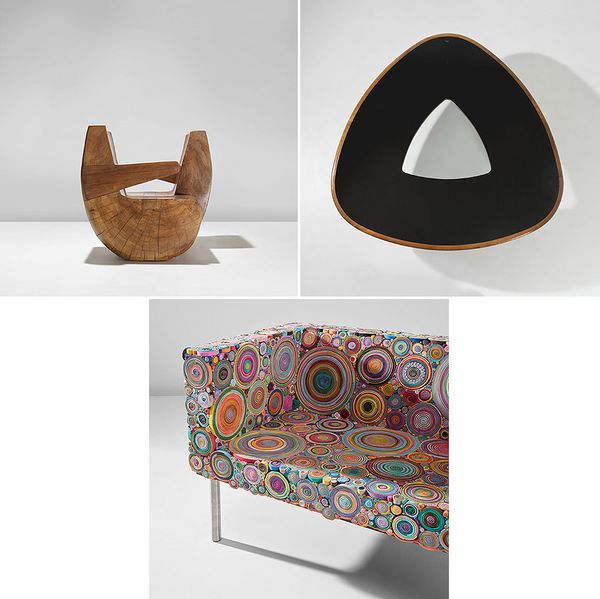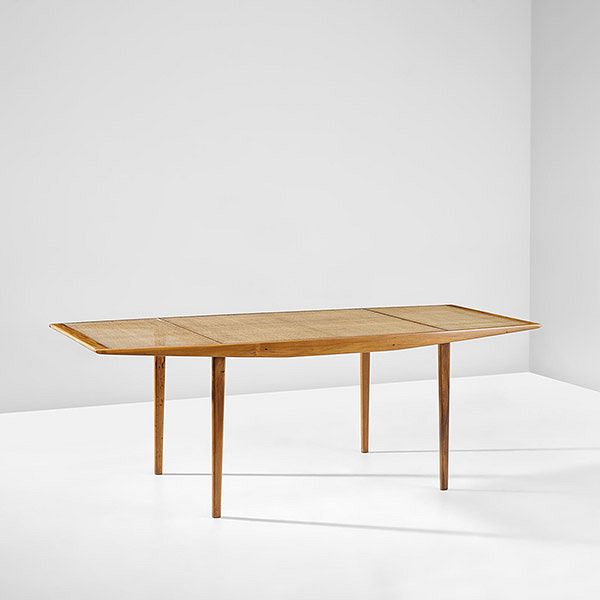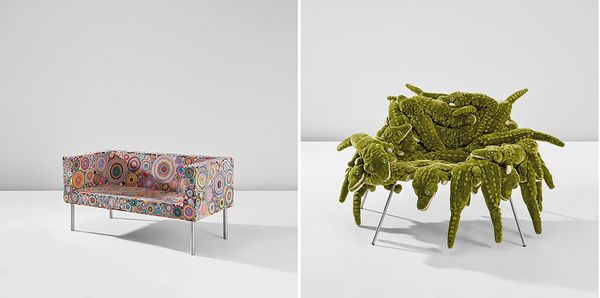Lot 28 José Zanine Caldas 'Namoradeira' rocking love seat, circa 1995 and Lot 21 (detail) Joaquim Tenreiro 'Mesa Triangular' dining table, circa 1960 and Lot 31 (detail) Fernando Campana and Humberto Campana 'Sushi' sofa, designed 2002, produced 2005. Design London.
By Amanda Beatriz Palma de Carvalho
Modern Brazilian design increasingly garners international focus due to the quality of its craftsmanship, innovation in forms, and use of a vast breadth of tropical hardwoods, many of which are found exclusively in Brazil. The fine quality of these materials embodies a rich cultural history while imparting lasting durability and functionality.
Figures essential to the nation’s design narrative such as Joaquim Tenreiro, José Zanine Caldas, Martin Eisler, Oscar Niemeyer, Carlo Hauner, Lina Bo Bardi, Sérgio Rodrigues, and more recently, the brothers Fernando and Humberto Campana, have their works displayed in some of the world's most prestigious museums. Expanding accession of these pieces into internationally revered collections is an attestation to their historical importance and demonstrates a commitment to preserving their legacy of artistic merit.
The quality of these furniture pieces can be seen in the current exhibition "Crafting Modernity: Design in Latin America, 1940-1980," at the Museum of Modern Art (MoMA) in New York. The entrance panel prominently features three furniture items by Brazilian designers signifying the strong influence of this nation’s design within the broader context of Latin America. The curation of these works and their distinguished placement at the forefront of the exhibition is a testament to their celebrated value within the international community of art and design.
Many of these distinctive pieces have become international references and were crafted by a pioneering generation of architects in the 1940s who chose to design intentionally modern furniture. An important aspect to highlight is the cross-cultural context in which they were conceived. Foreign architects and artists played an essential role in this process. Many came to Brazil seeking refuge from war-torn scenarios, finding a conducive environment in Brazil for their personal and professional growth. Conflicts which hindered the importation of products into Brazil created an opportunity for the development of domestic production. The work was guided by an aesthetic ideal more aligned with the times, considering materials and production capabilities available locally.
The Brazilian economy experienced large growth thereafter, with urbanization spreading throughout the country. This sense of fervor was further enhanced by the plans to create a new capital: Brasília. This sense of nation-building, with a character of potency and dynamism, contributed to the creation of a fertile and creative atmosphere and provided a significant platform for the engagement of architects. Consequently, Brazil emerged as an abundant setting for experimentation, garnering international recognition as a hub for architectural innovation and the arts through prominent features in leading global publications. The works by Oscar Niemeyer garnered admiration and discourse worldwide, leading him to collaborate with Le Corbusier on the design of the United Nations Headquarters in New York, a project initiated in 1949.
The zeitgeist of the era permeated the cities and buildings, yet there had been little expansion into the field of furniture design. It was during this period that architects and artists, many of them foreigners, recognized the absence of furniture that embodied the ideals of modernity to fit into these newly designed buildings and began to engage more in this area, catalyzing the growth of modern furniture production in Brazil. The following sections highlight the pioneering achievements of specific contributors to this era in design history.
Joaquim Tenreiro (1906, Portugal – 1992, Brazil)
Lot 21 Joaquim Tenreiro 'Mesa Triangular' dining table, circa 1960 and Lot 18 (detail) Joaquim Tenreiro and Regina Bolonha Unique coffee table, circa 1957 and Lot 25 Joaquim Tenreiro Pair of rare side tables, circa 1950. Design London.
Born in Portugal, son of a skilled wood joiner, Tenreiro arrived in Brazil in 1928 and initially began his career in furniture design creating eclectic pieces. It wasn't until 1942 that he realized his desire to create modern furniture, when he was commissioned to design and build the furniture for the residence of Francisco Inácio Peixoto in Cataguases, a project designed by Oscar Niemeyer.
From this time onwards, Tenreiro partnered with Langenbach, establishing Langenbach & Tenreiro Móveis e Decorações, where they began selling modern furniture. Tenreiro handled the technical and artistic aspects of the store which specialized in modern and stylish furniture, while Langenbach managed the commercial aspects.
Tenreiro was a virtuoso whose legacy became the main reference to an entire generation of Brazilian furniture designers. His profound knowledge of wood, its grain, and its durability enabled him to create lightweight and long-lasting furniture while using the minimum amount of material possible, thus imbuing his designs with a sleek appearance. The production of these pieces was entirely artisanal, with small editions, or in some cases, completely unique pieces.
Lina Bo Bardi (1914, Italy – 1992, Brazil)
Lot 20 Lina Bo Bardi Chair, designed for the SESC-Pompéia Center, São Paulo, circa 1980. Design London.
Born and trained in Italy where she studied residential interiors and furniture, Lina Bo Bardi came to Brazil with her husband, Pietro Maria Bardi, in 1947 and found fertile ground for her artistic endeavors. Bo Bardi designed museums, created the magazine Habitat, established Brazil's first design school, the Instituto de Arte Contemporânea (IAC), and was one of the pioneers in both the design and production of modern furniture in Brazil. Her architectural achievements include international references such as the MASP (Museu de Arte de São Paulo) and the SESC Pompéia cultural and leisure center in São Paulo.
Necessity shaped much of Bo Bardi’s approach: When she was tasked with the renovation of the building that would house the first MASP, located on Rua Sete de Abril in São Paulo, she needed a stackable chair for the auditorium, which was free from adornments and therefore fit the modern aesthetic. Not finding a piece that met her needs, she designed and produced a workable style herself. From this experience, she founded the Studio de Arte Palma and the PauBra workshop, in partnership with Giancarlo Palanti (1906, Italy – 1977, Brazil), where they designed modern furniture that was handmade and with forms that represented the modern ideals of the time. Lina Bo Bardi stands as one of the most influential figures of Brazilian modernism and her works leave a lasting legacy in design history.
Carlo Hauner (1927, Italy – 1996, Italy)
Lot 24 Carlo Hauner Pair of reclining armchairs, circa 1950. Design London.
Hauner studied design at the Brera Academy and had some success professionally in Milan prior to immigrating to Brazil in 1948. Upon his arrival to São Paulo, he exhibited paintings and prints at MASP and was invited by Lina Bo Bardi to teach a freehand drawing course for IAC students. This proximity led him to purchase the machinery of Bo Bardi’s PauBra factory to then create the Móveis Artesanal store, which subsequently evolved into the Forma store which he managed creatively with Martin Eisler.
The furniture designed by Hauner followed the internationally prevailing aesthetic. The Concha armchair became a benchmark of good taste and comfort, appearing in numerous homes featured in the major magazines of the 1950s. In 1957, Hauner returned to Italy, where, due to keen European interest in acquiring Forma’s furniture, he opened a branch of the factory and store in Brescia. The Italian branch received the ‘Compasso d’Oro’ award in Milan.
Martin Eisler (1913, Austria – 1977, Brazil)
Lot 23 Martin Eisler Dining table, 1960s. Design London.
While still in Europe, Eisler trained as an architect where he was influenced by the design philosophies and aesthetics of the Bauhaus. Immigrating to Argentina in 1938, he worked as an architect, set designer, and interior designer, founding his own company there with success for many years before professionally aligning with his contemporary, Carlo Hauner, and relocating to Brazil to design furniture in the early 1950s. A few years later, the two designers evolved the already successful Móveis Artesanal into Forma, strategically re-branding the business to attract more of the booming office-furniture market. Their store had a long-lasting and internationally recognized trajectory, receiving praise in renowned publications such as ‘Domus’ and ’Architeture’ in Italy, ’Aujourd'hui’ in France, ’Werk’ in Switzerland, and ‘Modern Furniture’ in America. Eisler's designs were particularly prominent for their resonance with international trends both in form and material usage.
José Zanine Caldas (1919, Brazil – 2001, Brazil)
Lot 28 José Zanine Caldas 'Namoradeira' rocking love seat, circa 1995. Design London.
In this early period of pioneers, we must also distinguish the work of the native Brazilian and self-taught artist José Zanine Caldas, who opened Fábrica Móveis Artísticos Z in 1949 in the city of São José dos Campos. Zanine was a true innovator across several varying disciplines and employed unorthodox approaches in his design execution, such as engaging with the Institute of Technical Research to commission thicker panels of plywood that were not typically considered for furniture, leveraging specialized materials production capabilities the organisation was developing for marine and aircraft fabrication. During this time, his furniture designs were modular, promoting the complete utilization of plywood panels and serial production. Caldas’s pieces from this period featured lightweight construction and organic forms.
From 1970 onwards, Caldas underwent a radical shift in his worldview that transformed his creative process. He perceived Brazil's industrialization as a dependency to more technologically advanced countries. In response, he relocated to Nova Viçosa, in southern Bahia, where he encountered remnants of wood left by a large lumber company that once operated in the region. The devastation of the forest and consequent waste upset him deeply. As a result, he proposed furniture crafted by hand, utilising the traditional technical knowledge of local craftsmen to create from the discarded materials. This approach often resulted in distinctive pieces which were specifically informed by the individual pieces of wood they were crafted from. Caldas believed that these furnishings would highlight deforestation issues while also serving as a testament to Brazil's abundant natural resources, even as he foresaw a future with fewer trees of such substantial dimensions. As a symbolic gesture, he often retained the original dimensions of the trees when creating his pieces.
Fernando Campana (1961, Brazil – 2022, Brazil) and Humberto Campana (1953, Brazil)
Lot 31 Fernando Campana and Humberto Campana 'Sushi' sofa, designed 2002, produced 2005 and Lot 94 Fernando Campana and Humberto Campana Prototype 'Alligator' chair, from the 'Banquete' series, designed 2002, produced 2003. Design London.
Humberto Campana is an architect, whilst Fernando was a self-taught designer and lawyer — the two brothers established the Campana Studio together in 1983. Their creations garnered significant public attention and international recognition due to their vibrancy and novelty, and quickly became icons of their era of Brazilian culture. One especially notable example is the ‘Favela’ Chair (1990), which pays homage to the Brazilian favela (slum) dwellers who built their homes from whatever remnants they could find. Characterized by confronting various adversities, a resilient and resourceful spirit of overcoming challenges with unique inventiveness is embodied in this work.
The Campana brothers’ pieces reflect Brazilian culture through a consciensious lens, simultaneously revealing current social and economic contradictions in meaningful and thought-provoking ways.
Discover More from Design London >
Recommended Reading
The Emergence of the Master: Ettore Sotsass >
Beauty Suspended in Time: Shiro Kuramata >
A Masterpiece of Brazilian Modern Design >
Antiquity Made Modern: Diego Giacometti >
Elevation of the Human Spirit through Postmodern Design: Alessandro Mendini >






